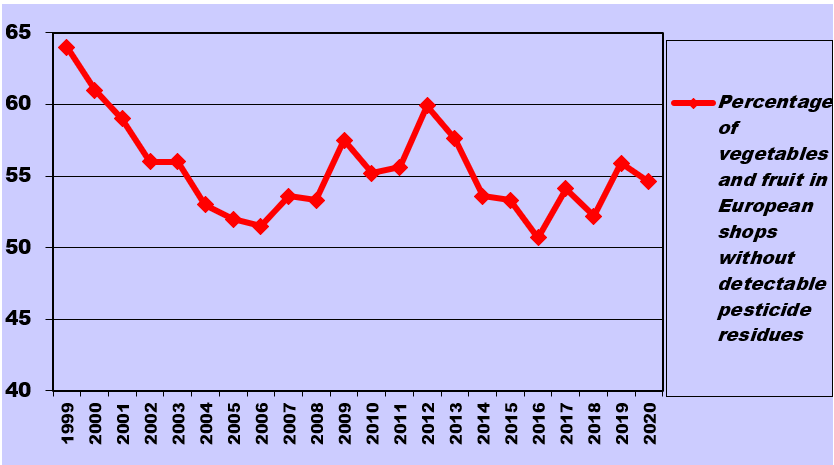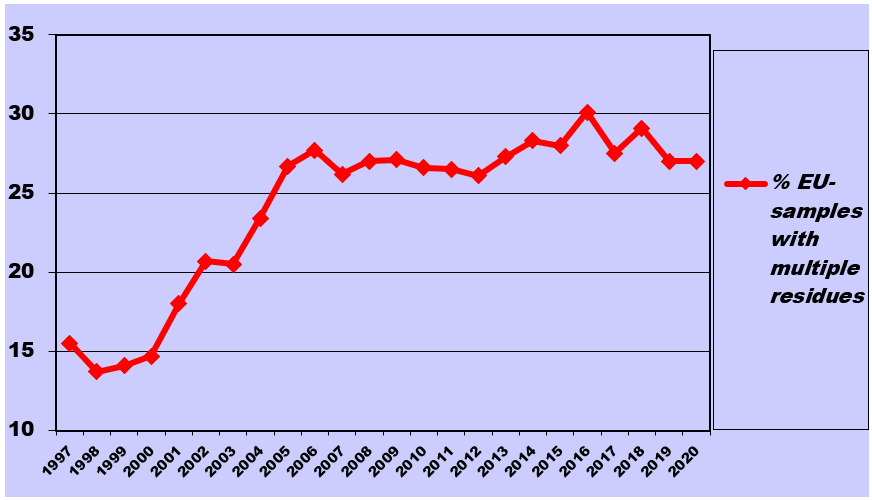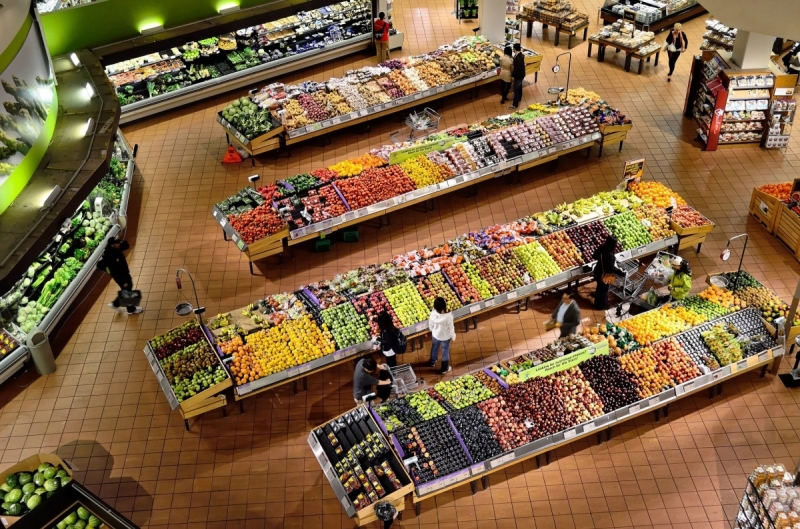On 24 February 2022, the European Food Safety Authority (EFSA) published its latest annual report on pesticide residues in food for the year 2020[1]. Data show that half of the fruit and vegetables on the European market are still contaminated with residues of at least one pesticide, while a quarter of them contains a cocktail of up to 15 pesticide residues. Science reports that exposure to such residues might have a significant impact on people’s health, including unborn children. Yet, EFSA’s report fails one more time to highlight the real shortcomings of the regulatory system in terms of consumer protection.
EFSA's conclusions are the followings:
- For 2020, 94.9% of the overall food samples tested fell below the maximum residue level (MRL), the legal limits allowed under the EU Regulation (vs. 96.1% in 2019). Out of the 5.1 remaining % exceeding this legal, only 3.6% can be regarded as non-compliant to an uncertainty factor in measurement.
- According to EFSA’s methodology, the dietary exposure to pesticide residue is “unlikely to pose a risk to EU consumer health”.
Reading these few lines of summary, which are often where readers stop, suggests that all is well: the EU Regulation is massively enforced, and supported by a dietary exposure methodology of EFSA which concludes that, although pesticide residues are everywhere, they do no harm! PAN Europe challenges this biased methodology[2] and the conclusions drawn from it, which we consider misleading for consumers, in the way they are introduced.
Therefore, PAN Europe has analysed the results of this report in more detail to come up with more meaningful and alarming findings for consumers. According to our own analysis, no progress has been made in terms of food contamination and cocktail effect’s exposure over the last 10 years! Our graphs even suggest an increase trend in the presence of pesticide residues in food, whereas the European Commission welcomes a reduction in the use & the risk of pesticides since 2018[3]!
- In 2020, close to half of the fruit and vegetables consumed in the EU was polluted with one or more pesticide residues. The percentage of vegetables and fruit in European shops without detectable (below analytical detection limit) pesticide residues went slightly down to 54,6%, reinforcing the trend of recent years towards higher and higher levels of pesticide residues.

- In 2020, a quarter (27%) of fruit and vegetables consumed in Europe contained multiple residues of pesticides. This very high figure of 27% remained unchanged in comparison with 2019. This cocktail can be up to 14 pesticides in a pear or 15 pesticides in a rice sample.

The highest frequency of multiple residues in unprocessed products was reported for sweet peppers/bell peppers, apples, oranges, pears, strawberries, table grapes, mandarins and peaches. All are common products, consumed daily by European consumers.
In lingo, this implies chronic dietary exposure of consumers to a cocktail of pesticide residues, whose cumulative adverse effects are now largely reported but poorly assessed[4]. In circumstances where cocktail effects are not considered, we hardly understand how EFSA can exclude risks to consumers. This misleading and unscientific communication is unacceptable!
In parallel, science is evolving. A recent study[5] suggests that consumers eating fruits and vegetables with generally higher levels of pesticide residues tend to have more chronic diseases than those eating food with lower levels of pesticides. Those eating lower levels of pesticides have a 36% lower mortality risk. This publication suggests that pesticide residues in food counter the health benefit of eating fruits and vegetables. Such findings question even more the communication from EFSA, denying the lack of assessment of the risk posed by pesticide residues in food!
In the context of the Sustainable Use Directive revision, these findings also show that the current risk-based indicators for pesticide reduction in the context of the Farm to Fork Strategy are not suitable as they do not reflect, or even mask, the increasing presence of pesticide residues in food (but also in the environment).
Notes:
[1] Pesticides in food: latest report published
[3] EU: Trends
[4] Cf.2
[5] https://www.sciencedirect.com/science/article/pii/S0160412021006498
